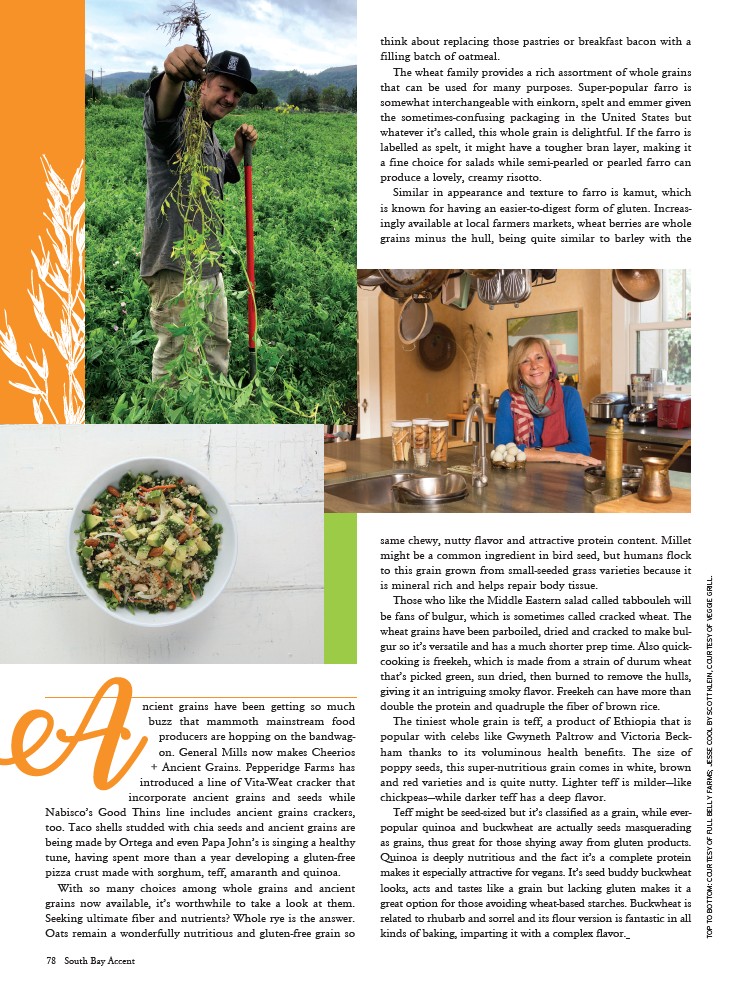
ncient grains have been getting so much
buzz that mammoth mainstream food
producers are hopping on the bandwagon.
General Mills now makes Cheerios
+ Ancient Grains. Pepperidge Farms has
introduced a line of Vita-Weat cracker that
incorporate ancient grains and seeds while
Nabisco’s Good Thins line includes ancient grains crackers,
too. Taco shells studded with chia seeds and ancient grains are
being made by Ortega and even Papa John’s is singing a healthy
tune, having spent more than a year developing a gluten-free
pizza crust made with sorghum, teff, amaranth and quinoa.
With so many choices among whole grains and ancient
grains now available, it’s worthwhile to take a look at them.
Seeking ultimate fiber and nutrients? Whole rye is the answer.
Oats remain a wonderfully nutritious and gluten-free grain so
think about replacing those pastries or breakfast bacon with a
filling batch of oatmeal.
The wheat family provides a rich assortment of whole grains
that can be used for many purposes. Super-popular farro is
somewhat interchangeable with einkorn, spelt and emmer given
the sometimes-confusing packaging in the United States but
whatever it’s called, this whole grain is delightful. If the farro is
labelled as spelt, it might have a tougher bran layer, making it
a fine choice for salads while semi-pearled or pearled farro can
produce a lovely, creamy risotto.
Similar in appearance and texture to farro is kamut, which
is known for having an easier-to-digest form of gluten. Increasingly
available at local farmers markets, wheat berries are whole
grains minus the hull, being quite similar to barley with the
same chewy, nutty flavor and attractive protein content. Millet
might be a common ingredient in bird seed, but humans flock
to this grain grown from small-seeded grass varieties because it
is mineral rich and helps repair body tissue.
Those who like the Middle Eastern salad called tabbouleh will
be fans of bulgur, which is sometimes called cracked wheat. The
wheat grains have been parboiled, dried and cracked to make bulgur
so it’s versatile and has a much shorter prep time. Also quickcooking
is freekeh, which is made from a strain of durum wheat
that’s picked green, sun dried, then burned to remove the hulls,
giving it an intriguing smoky flavor. Freekeh can have more than
double the protein and quadruple the fiber of brown rice.
The tiniest whole grain is teff, a product of Ethiopia that is
popular with celebs like Gwyneth Paltrow and Victoria Beckham
thanks to its voluminous health benefits. The size of
poppy seeds, this super-nutritious grain comes in white, brown
and red varieties and is quite nutty. Lighter teff is milder—like
chickpeas—while darker teff has a deep flavor.
Teff might be seed-sized but it’s classified as a grain, while everpopular
quinoa and buckwheat are actually seeds masquerading
as grains, thus great for those shying away from gluten products.
Quinoa is deeply nutritious and the fact it’s a complete protein
makes it especially attractive for vegans. It’s seed buddy buckwheat
looks, acts and tastes like a grain but lacking gluten makes it a
great option for those avoiding wheat-based starches. Buckwheat is
related to rhubarb and sorrel and its flour version is fantastic in all
kinds of baking, imparting it with a complex flavor.
78 South Bay Accent
TOP TO BOTTOM: COURTESY OF FULL BELLY FARMS; JESSE COOL BY SCOTT KLEIN, COURTESY OF VEGGIE GRILL.